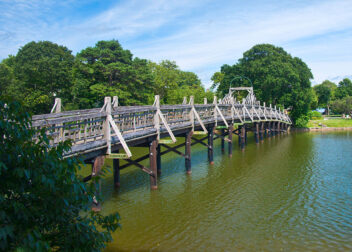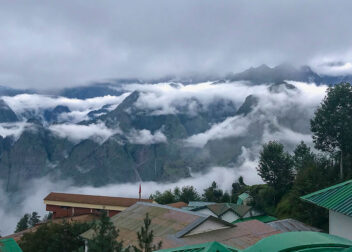Lakhpat fort
Lakhpat Fort is a historical fort located in the Kutch district of the Indian state of Gujarat. It was built in the 18th century by Rao Lakhpatji, the ruler of the Kutch State. The fort is situated on the banks of the Kori Creek, which flows into the Arabian Sea.
The Lakhpat Fort was built to protect the Kutch region from foreign invaders, particularly from the north-west. It was constructed using sandstone and has several bastions and ramparts. The fort is also home to several temples and other religious structures, including a mosque, a temple dedicated to Lord Shiva, and a gurudwara.
The fort has a rich history and played a significant role in the Indian independence movement. It served as a refuge for several freedom fighters, including Mahatma Gandhi, during the Salt Satyagraha movement. The fort also witnessed a devastating earthquake in 1819, which led to a decline in its importance.
Today, the Lakhpat Fort is a popular tourist attraction and is visited by history enthusiasts, photographers, and travelers interested in exploring the rich cultural heritage of Gujarat.
History
The Lakhpat Fort was built in the 18th century by Rao Lakhpatji, the ruler of the Kutch State. It was constructed to protect the Kutch region from foreign invaders, particularly from the northwest. The fort was built using sandstone and has several bastions and ramparts.
During the 19th century, the British East India Company took control of the Kutch region, and the fort lost its strategic importance. In 1819, a devastating earthquake struck the region, causing significant damage to the fort and leading to a decline in its importance.
During India’s struggle for independence, the Lakhpat Fort played a significant role. In 1930, as part of the Salt Satyagraha movement, Mahatma Gandhi visited the fort and used it as a refuge from the British authorities. He stayed in the fort for several days, and his visit brought national attention to the movement.
After India gained independence in 1947, the fort was abandoned and fell into disrepair. However, in recent years, efforts have been made to restore and preserve the fort, and it has become a popular tourist attraction, drawing visitors interested in exploring its rich cultural heritage.
Lakhpat Fort Architecture
The architecture of Lakhpat Fort is a fine example of the defensive structures that were built in India during the 18th century. The fort was constructed using sandstone, and it has several bastions and ramparts that were designed to provide protection against enemy attacks.
The fort is rectangular in shape and covers an area of around 7 acres. It has four main gates, each of which has a different name and was designed for a specific purpose. The gates are named after the cardinal directions, with the eastern gate being the main entrance.
The fort has several defensive features, such as bastions, ramparts, and watchtowers, which are strategically placed to provide maximum protection to the fort. The bastions are equipped with cannon platforms, which were used to defend the fort against enemy attacks.
Apart from the defensive structures, the Lakhpat Fort also has several religious structures, including a mosque, a temple dedicated to Lord Shiva, and a gurudwara. These structures are located within the fort and are an essential part of the fort’s architecture.
Overall, the architecture of Lakhpat Fort is a testament to the ingenuity and creativity of Indian architects and engineers during the 18th century. The fort’s design and construction reflect the need for defensive structures that could withstand enemy attacks while also providing a safe haven for the people within its walls.
Facts
Here are some interesting facts about Lakhpat Fort:
- Lakhpat Fort is one of the largest forts in the Kutch district of Gujarat, India, covering an area of around 7 acres.
- The fort was built in the 18th century by Rao Lakhpatji, the ruler of the Kutch State.
- Lakhpat Fort was strategically built to protect the Kutch region from foreign invaders, particularly from the north-west.
- The fort has four main gates, each of which has a different name and was designed for a specific purpose. The eastern gate is the main entrance.
- The fort has several defensive structures, such as bastions, ramparts, and watchtowers, which were designed to provide maximum protection to the fort.
- The fort also has several religious structures, including a mosque, a temple dedicated to Lord Shiva, and a gurudwara.
- During India’s struggle for independence, Mahatma Gandhi stayed in the Lakhpat Fort as a refuge from the British authorities during the Salt Satyagraha movement in 1930.
- In 1819, a devastating earthquake struck the region, causing significant damage to the fort and leading to a decline in its importance.
- Today, the Lakhpat Fort is a popular tourist attraction and draws visitors interested in exploring its rich cultural heritage.
- The fort’s architecture is a fine example of the defensive structures built in India during the 18th century and is a testament to the ingenuity and creativity of Indian architects and engineers of the time.
How to reach
Lakhpat Fort is located in the Kutch district of Gujarat, India. Here are the different ways to reach the fort:
- By Air: The nearest airport to Lakhpat Fort is the Bhuj Airport, which is about 135 km away. From the airport, you can hire a taxi or take a bus to reach the fort.
- By Train: The nearest railway station is Bhuj Railway Station, which is about 135 km away. From the railway station, you can hire a taxi or take a bus to reach the fort.
- By Road: Lakhpat Fort is well-connected by road to major cities in Gujarat. You can take a bus or hire a taxi from Bhuj, which is about 135 km away. Alternatively, you can also drive to the fort.
- Private Tours: Private tours are also available, which can take you to Lakhpat Fort as part of a tour package. These tours usually include transportation, food, and a guide.
It is recommended to plan your trip in advance and check for any travel restrictions or guidelines before visiting the fort. The best time to visit Lakhpat Fort is from October to March when the weather is pleasant.
FAQ
Q: What is the history of Lakhpat Fort?
A: Lakhpat Fort was built in the 18th century by Rao Lakhpatji, the ruler of the Kutch State. It was constructed to protect the Kutch region from foreign invaders, particularly from the north-west. During India’s struggle for independence, Mahatma Gandhi stayed in the Lakhpat Fort as a refuge from the British authorities during the Salt Satyagraha movement in 1930.
Q: What is the architecture of Lakhpat Fort?
A: The architecture of Lakhpat Fort is a fine example of the defensive structures that were built in India during the 18th century. The fort was constructed using sandstone, and it has several bastions and ramparts that were designed to provide protection against enemy attacks. The fort also has several religious structures, including a mosque, a temple dedicated to Lord Shiva, and a gurudwara.
Q: How can I reach Lakhpat Fort?
A: Lakhpat Fort is located in the Kutch district of Gujarat, India. You can reach the fort by air, train, or road. The nearest airport and railway station are both located in Bhuj, which is about 135 km away. From Bhuj, you can hire a taxi or take a bus to reach the fort. Private tours are also available.
Q: What are the timings and entry fees of Lakhpat Fort?
A: The timings and entry fees of Lakhpat Fort may vary, so it is best to check with the local authorities or the fort management before visiting. Generally, the fort is open from morning until evening, and there is a nominal entry fee for visitors.



